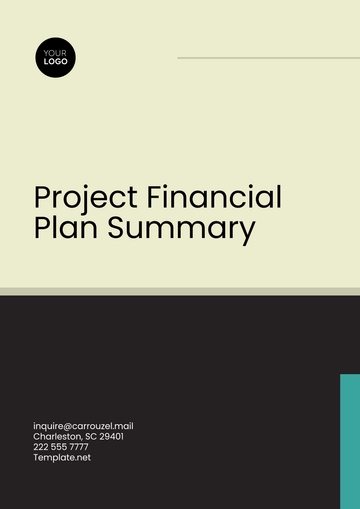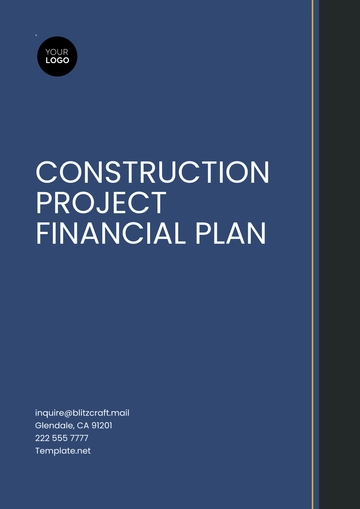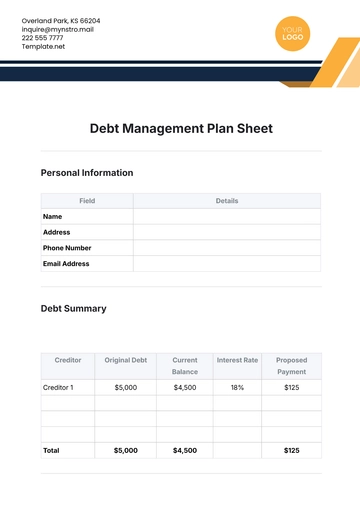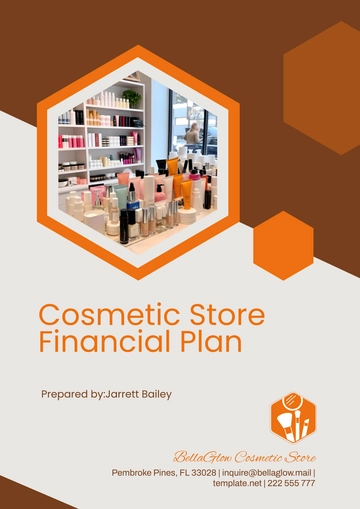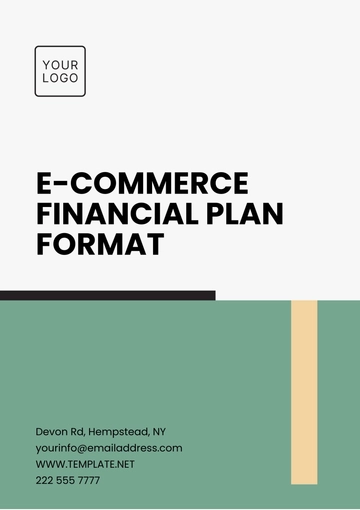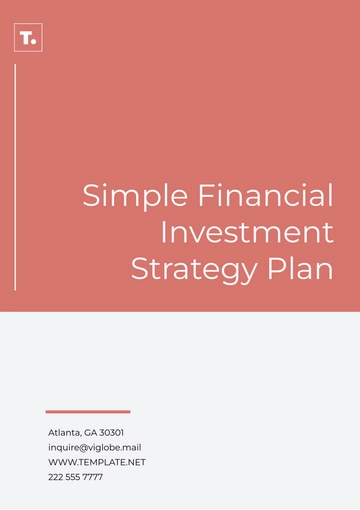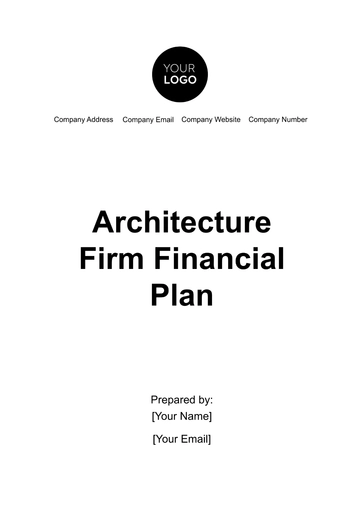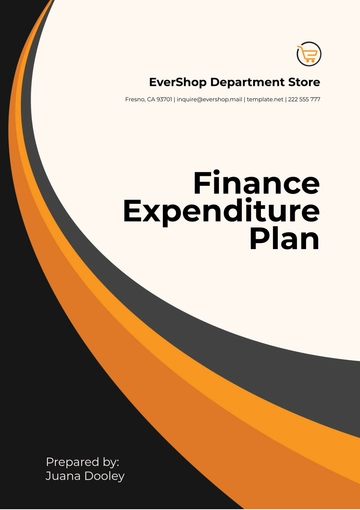Free Go-to-Market Financial Plan

1. Executive Summary
1.1 Overview
The Go-to-Market (GTM) Financial Plan for [Your Company Name] outlines the strategic approach for launching our innovative product line in the year [2050]. This comprehensive plan provides an in-depth analysis of the market landscape, defines our financial projections, and establishes the funding requirements needed to ensure a successful entry into the market. By laying out a well-structured approach to market entry, we aim to minimize risks while maximizing opportunities for growth.
In an era characterized by rapid technological advancements and changing consumer preferences, it is essential for [Your Company Name] to effectively position itself to meet the evolving demands of our target audience. With a focus on sustainability and innovation, we aim to capture the interest of eco-conscious consumers while also addressing their desire for convenience and efficiency. By strategically leveraging financial resources, we will ensure the sustainability and growth of our operations in a highly competitive environment.
1.2 Objectives
The primary objectives of this GTM Financial Plan are as follows:
Achieve Market Penetration: Establish a significant presence in our target market within [3] years, aiming for at least [15%] market share by 2053. This aggressive goal reflects our commitment to innovation and customer satisfaction.
Revenue Growth: Attain annual revenue growth of [20%] for the first [5] years post-launch, eventually reaching a projected total revenue of [$150 million] by 2055. This growth will be driven by a combination of innovative product features, effective marketing strategies, and strong customer engagement.
Profitability: Achieve profitability by the end of year [3], with net profit margins stabilizing at around [25%] thereafter. A clear focus on managing costs and increasing operational efficiency will play a key role in achieving this objective.
Funding Acquisition: Secure funding of at least [$5 million] to support initial marketing, production, and operational costs. This funding will be essential for scaling our operations and ensuring that we meet our growth targets.
1.3 Financial Highlights
The following financial highlights summarize the key components of our financial plan, illustrating our anticipated growth trajectory and financial health:
Financial Metrics | Year 2050 | Year 2051 | Year 2052 | Year 2053 | Year 2055 |
|---|---|---|---|---|---|
Projected Revenue | [$5 million] | [$10 million] | [$20 million] | [$30 million] | [$150 million] |
Projected Expenses | [$3 million] | [$6 million] | [$12 million] | [$15 million] | [$100 million] |
Net Profit | [$2 million] | [$4 million] | [$8 million] | [$15 million] | [$50 million] |
Funding Required | [$5 million] |
This financial plan serves as a roadmap for [Your Company Name] as we navigate the complexities of entering a new market, aligning our strategies to capitalize on opportunities while managing potential risks. By keeping a close eye on our financial performance and adjusting our strategies as needed, we will ensure that we remain on track to achieve our goals.
2. Market Analysis
2.1 Market Overview
The global market in 2050 is projected to be worth over [$10 trillion], with significant growth driven by technological advancements and demographic shifts. Emerging economies are expected to contribute to [60%] of global consumption, highlighting the importance of expanding our reach into these developing markets. The increasing disposable income among consumers, particularly in Asia and Africa, will provide new opportunities for businesses that can deliver innovative products that meet local needs.
2.2 Target Market
[Your Company Name] will primarily focus on the following segments within our target market:
Millennials and Gen Z: This demographic is characterized by a strong inclination towards technology and sustainability. Approximately [30%] of this group is willing to pay a premium for eco-friendly products, making them a crucial target for our marketing efforts. Their affinity for digital engagement will shape our online marketing strategies and product development.
Small to Medium Enterprises (SMEs): SMEs are increasingly adopting innovative technologies to enhance their operational efficiency. They represent a significant portion of the market, with an estimated [$25 million] SMEs in the U.S. alone. By offering tailored solutions that address the specific needs of this segment, [Your Company Name] can tap into a lucrative market that values efficiency and innovation.
Urban Dwellers: Consumers living in urban areas often seek convenience and high-quality products. This segment is anticipated to grow by [10%] annually, making it a key focus for our marketing efforts. Urban dwellers are also more likely to embrace new technologies, particularly those that enhance their lifestyle and reduce their environmental impact.
2.3 Competitive Landscape
The competitive landscape for [Your Company Name] consists of several established players and emerging startups. Key competitors include:
Company A: A market leader known for its extensive product range and robust distribution channels. With a market share of [20%], Company A has established itself as a trusted brand among consumers, which presents both challenges and opportunities for [Your Company Name].
Company B: A niche player focused on eco-friendly products, capturing [10%] of the market. Their commitment to sustainability resonates well with our target audience, highlighting the importance of differentiating our offerings to stand out.
Company C: A rapidly growing startup that has gained popularity among Millennials, with a market share of [5%]. Their agile approach to product development and marketing serves as a reminder of the need for [Your Company Name] to remain flexible and responsive to market trends.
2.4 Market Trends
Several trends are shaping the market landscape in 2050:
Technological Integration: The integration of AI and IoT technologies in products and services is becoming a necessity, with [75%] of consumers expressing a preference for smart solutions. This trend emphasizes the need for [Your Company Name] to leverage cutting-edge technology to enhance product functionality and customer experience.
Sustainability: There is an increasing demand for sustainable and ethically sourced products, with [70%] of consumers willing to change brands if their preferred brand does not prioritize sustainability. This trend aligns perfectly with our company values and product offerings, providing us with a unique opportunity to capture market share by emphasizing our commitment to eco-friendly practices.
Health and Wellness: The health-conscious consumer trend is leading to the growth of organic and natural products, with the market expected to reach [$300 billion] by 2055. By positioning our products within this growing sector, [Your Company Name] can tap into a health-focused consumer base that prioritizes quality and sustainability.
3. Product Offering
3.1 Product Description
[Your Company Name] will offer a range of innovative products designed to cater to the needs of our target market. Our product line will include advanced smart home devices that seamlessly integrate with existing home systems, providing users with the ability to control their environment efficiently and conveniently. These products will not only focus on enhancing comfort but also prioritize reducing energy consumption, contributing to a more sustainable lifestyle.
Our flagship product is a smart home device that enables users to manage energy usage in real-time, optimizing their power consumption based on usage patterns. This product aims to provide significant cost savings for consumers while simultaneously reducing their carbon footprint. In addition, our product line will include accessories such as smart sensors and controllers that further enhance user experience and functionality.
3.2 Unique Selling Proposition (USP)
The unique selling proposition of our product lies in its combination of advanced technology and sustainability. Unlike our competitors, we prioritize eco-friendly materials and energy-efficient designs, ensuring that our customers make responsible choices without sacrificing performance. Our commitment to sustainability is not just a marketing strategy; it is ingrained in our product development processes and company values.
Additionally, our products will feature advanced machine learning algorithms, enabling them to adapt to user preferences over time. This level of personalization will not only enhance the user experience but also foster customer loyalty, as users will feel that the product evolves to meet their specific needs. Our USP will be communicated through our marketing campaigns, emphasizing the dual benefits of innovation and sustainability.
3.3 Pricing Strategy
Our pricing strategy will reflect the premium quality of our products while remaining competitive within the market. The pricing tiers will be established based on market research and competitive analysis, with an emphasis on maintaining profitability while remaining accessible to our target market. The following pricing strategy will be adopted:
Product Category | Estimated Retail Price | Expected Profit Margin |
|---|---|---|
Smart Home Device | [$250] | [30%] |
Smart Sensors | [$75] | [40%] |
Smart Controllers | [$100] | [35%] |
This pricing strategy aims to balance affordability with profitability, ensuring that we can invest in marketing and product development while still offering competitive pricing to our customers. The pricing will be reviewed annually, taking into account changes in production costs, market demand, and competitor pricing.
4. Marketing Strategy
4.1 Marketing Channels
To effectively reach our target market, [Your Company Name] will employ a multi-channel marketing strategy that encompasses both digital and traditional marketing avenues. Key marketing channels will include:
Social Media: Utilizing platforms such as Instagram, Facebook, and LinkedIn to engage with our target audience, share educational content, and promote our products. Social media campaigns will be tailored to resonate with each demographic, with a focus on showcasing our commitment to sustainability and innovation.
Email Marketing: Implementing targeted email campaigns to nurture leads and keep customers informed about new product launches, promotions, and sustainability initiatives. Personalization and segmentation will be key strategies in our email marketing efforts, ensuring that content is relevant to the recipient's interests.
Content Marketing: Creating valuable content, including blog posts, videos, and infographics, that educates consumers about the benefits of our products and the importance of sustainability. This content will not only drive traffic to our website but also establish [Your Company Name] as an authority in the smart home and sustainability sectors.
Partnerships and Collaborations: Forming strategic partnerships with eco-friendly brands and influencers to co-market our products and enhance our reach. Collaborations will include joint promotions, content sharing, and influencer marketing campaigns that amplify our brand message.
4.2 Promotion Strategies
Our promotion strategies will focus on building brand awareness and driving product adoption. Key promotional tactics include:
Launch Events: Hosting product launch events and webinars to showcase our innovative solutions and engage directly with potential customers. These events will provide an opportunity to demonstrate product functionality, answer questions, and create excitement around our brand.
Incentives and Discounts: Offering introductory discounts and referral incentives to encourage early adoption and word-of-mouth marketing. These strategies will help to build a loyal customer base while generating initial sales momentum.
Public Relations: Engaging with media outlets to secure press coverage and reviews of our products, leveraging third-party validation to build credibility. A well-executed PR campaign will position [Your Company Name] favorably within the industry and attract consumer interest.
4.3 Sales Strategy
The sales strategy for [Your Company Name] will include both direct and indirect sales channels. Our approach will involve:
E-commerce Platform: Launching our own online store to facilitate direct sales and provide customers with a seamless shopping experience. The website will feature detailed product descriptions, customer testimonials, and educational content to enhance the buying process.
Retail Partnerships: Establishing relationships with major retail chains and online marketplaces to expand our reach and increase product visibility. Partnering with reputable retailers will help us gain credibility and attract customers who prefer purchasing in-store or through established platforms.
Customer Support and Engagement: Providing exceptional customer service through multiple channels, including chat support, email, and phone. Ensuring a positive customer experience will be paramount, as satisfied customers are more likely to become repeat buyers and brand advocates.
5. Financial Projections
5.1 Revenue Model
The revenue model for [Your Company Name] will be based on a combination of product sales, subscription services, and potential licensing agreements. Our primary revenue streams will include:
Direct Product Sales: Revenue generated from the sale of our smart home devices and accessories will form the core of our business model. This model allows for immediate revenue recognition and provides valuable insights into customer preferences and purchasing behavior.
Subscription Services: We will offer subscription-based services for advanced features and ongoing software updates, providing users with additional value while generating recurring revenue. This model not only enhances customer retention but also creates a stable revenue stream.
Licensing Agreements: Exploring potential licensing agreements with other brands to integrate our technology into their products, further diversifying our revenue sources. These partnerships can enhance our market reach while minimizing risks associated with product development.
5.2 Cost Structure
Understanding our cost structure is essential for maintaining profitability and making informed business decisions. Key components of our cost structure include:
Cost Category | Year 2050 | Year 2051 | Year 2052 | Year 2053 | Year 2055 |
|---|---|---|---|---|---|
Production Costs | [$1 million] | [$2 million] | [$4 million] | [$6 million] | [$40 million] |
Marketing Expenses | [$1 million] | [$2 million] | [$3 million] | [$5 million] | [$25 million] |
Operational Expenses | [$1 million] | [$2 million] | [$3 million] | [$4 million] | [$30 million] |
Total Costs | [$3 million] | [$6 million] | [$10 million] | [$15 million] | [$95 million] |
Production Costs: These costs are anticipated to increase significantly as we scale operations and ramp up production. Strategic negotiations with suppliers and manufacturers will be crucial in managing these expenses effectively.
Marketing Expenses: Marketing expenses will increase in the initial years as we invest in brand awareness and customer acquisition. This spending will be carefully monitored to ensure a strong return on investment.
Operational Expenses: Operational expenses will also grow as we expand our team and infrastructure. Maintaining efficiency will be vital to ensure that our operations can support our growth without compromising on service quality.
5.3 Profitability Analysis
The profitability analysis will evaluate our projected net profit margins over the first [5] years, allowing us to assess our financial health and sustainability:
Year | Revenue | Total Costs | Net Profit | Profit Margin |
|---|---|---|---|---|
Year 2050 | [$5 million] | [$3 million] | [$2 million] | [40%] |
Year 2051 | [$10 million] | [$6 million] | [$4 million] | [40%] |
Year 2052 | [$20 million] | [$10 million] | [$10 million] | [50%] |
Year 2053 | [$30 million] | [$15 million] | [$15 million] | [50%] |
Year 2055 | [$150 million] | [$95 million] | [$55 million] | [37%] |
The increasing net profit margin reflects our ability to optimize operations and effectively manage costs as we grow. By implementing robust financial controls and focusing on operational efficiency, we will ensure sustainable profitability while maintaining competitive pricing.
6. Funding Requirements
6.1 Funding Needs
To successfully launch and scale our operations, [Your Company Name] requires a total funding of [$5 million]. This capital will be crucial for product development, marketing initiatives, and operational expenses in the initial years. Securing this funding will provide the necessary resources to establish our brand and achieve our growth objectives.
6.2 Use of Funds
The allocation of funds will be structured as follows:
Funding Category | Amount | Percentage of Total Funds |
|---|---|---|
Product Development | [$2 million] | [40%] |
Marketing Initiatives | [$1.5 million] | [30%] |
Operational Expenses | [$1 million] | [20%] |
Contingency Fund | [$500,000] | [10%] |
This structured approach will ensure that funds are utilized effectively to achieve our strategic objectives. Each allocation is designed to maximize impact while minimizing risk, allowing [Your Company Name] to operate efficiently and scale effectively.
6.3 Exit Strategy
As part of our long-term planning, [Your Company Name] envisions several exit strategies, including:
Acquisition: Positioning the company for acquisition by a larger player in the industry looking to enhance their product offerings and market share. By developing strong brand equity and a loyal customer base, we can attract potential buyers who see value in our business.
Public Offering: Considering an initial public offering (IPO) if we achieve significant growth and market presence by 2055. This route would provide an opportunity to raise additional capital for further expansion while offering liquidity to early investors.
Merger: Exploring strategic mergers with complementary companies to enhance our capabilities and reach. Collaborating with other firms could enable us to leverage synergies, reduce operational costs, and access new markets more effectively.
7. Risks and Mitigation Strategies
7.1 Market Risks
Market risks include changing consumer preferences and increased competition. To mitigate these risks, [Your Company Name] will continuously monitor market trends and consumer feedback to adapt our product offerings accordingly. Engaging in regular market research and leveraging data analytics will enhance our ability to anticipate shifts in demand.
Additionally, we will maintain an agile product development cycle, allowing us to innovate rapidly and respond to consumer needs. By establishing a strong brand presence and fostering relationships with customers, we can build loyalty and reduce vulnerability to competitive pressures.
7.2 Financial Risks
Financial risks encompass fluctuating costs, revenue volatility, and funding challenges. To address these concerns, we will implement strict budget controls and conduct regular financial audits to ensure adherence to our financial goals. Establishing a contingency fund of [$500,000] will provide a buffer to cover unexpected costs.
Additionally, diversifying our revenue streams through subscription services and licensing agreements will provide stability and reduce reliance on product sales alone. Continuous monitoring of key financial metrics will ensure we remain proactive in addressing any potential challenges.
7.3 Operational Risks
Operational risks include supply chain disruptions and staffing challenges. To mitigate these risks, [Your Company Name] will establish relationships with multiple suppliers to ensure flexibility and minimize dependency on any single source.
Investing in employee training and development will enhance team productivity and morale, reducing turnover and operational disruptions. Implementing efficient operational processes and utilizing technology to streamline workflows will further strengthen our resilience against potential risks.
8. Conclusion
The Go-to-Market Financial Plan for [Your Company Name] outlines a strategic approach to launching our innovative product line in 2050. By leveraging thorough market analysis, a strong product offering, and a comprehensive marketing strategy, we are poised for success in a rapidly evolving marketplace.
Through careful financial planning and resource allocation, we will achieve our growth objectives while minimizing risks. Our commitment to sustainability, innovation, and customer satisfaction will drive our efforts as we establish [Your Company Name] as a leader in the smart home industry.
This financial plan serves as a roadmap for navigating the complexities of market entry and ensuring long-term success. With a focus on profitability, market penetration, and operational efficiency, [Your Company Name] is well-positioned to thrive in the dynamic landscape of 2050 and beyond.
- 100% Customizable, free editor
- Access 1 Million+ Templates, photo’s & graphics
- Download or share as a template
- Click and replace photos, graphics, text, backgrounds
- Resize, crop, AI write & more
- Access advanced editor
Plan your financial roadmap with the Go-to-Market Financial Plan Template from Template.net. This editable and customizable template provides a structured approach to project revenues, expenses, and profitability. Use our Ai Editor Tool to personalize it for accurate financial projections that support your market strategy.
You may also like
- Finance Plan
- Construction Plan
- Sales Plan
- Development Plan
- Career Plan
- Budget Plan
- HR Plan
- Education Plan
- Transition Plan
- Work Plan
- Training Plan
- Communication Plan
- Operation Plan
- Health And Safety Plan
- Strategy Plan
- Professional Development Plan
- Advertising Plan
- Risk Management Plan
- Restaurant Plan
- School Plan
- Nursing Home Patient Care Plan
- Nursing Care Plan
- Plan Event
- Startup Plan
- Social Media Plan
- Staffing Plan
- Annual Plan
- Content Plan
- Payment Plan
- Implementation Plan
- Hotel Plan
- Workout Plan
- Accounting Plan
- Campaign Plan
- Essay Plan
- 30 60 90 Day Plan
- Research Plan
- Recruitment Plan
- 90 Day Plan
- Quarterly Plan
- Emergency Plan
- 5 Year Plan
- Gym Plan
- Personal Plan
- IT and Software Plan
- Treatment Plan
- Real Estate Plan
- Law Firm Plan
- Healthcare Plan
- Improvement Plan
- Media Plan
- 5 Year Business Plan
- Learning Plan
- Marketing Campaign Plan
- Travel Agency Plan
- Cleaning Services Plan
- Interior Design Plan
- Performance Plan
- PR Plan
- Birth Plan
- Life Plan
- SEO Plan
- Disaster Recovery Plan
- Continuity Plan
- Launch Plan
- Legal Plan
- Behavior Plan
- Performance Improvement Plan
- Salon Plan
- Security Plan
- Security Management Plan
- Employee Development Plan
- Quality Plan
- Service Improvement Plan
- Growth Plan
- Incident Response Plan
- Basketball Plan
- Emergency Action Plan
- Product Launch Plan
- Spa Plan
- Employee Training Plan
- Data Analysis Plan
- Employee Action Plan
- Territory Plan
- Audit Plan
- Classroom Plan
- Activity Plan
- Parenting Plan
- Care Plan
- Project Execution Plan
- Exercise Plan
- Internship Plan
- Software Development Plan
- Continuous Improvement Plan
- Leave Plan
- 90 Day Sales Plan
- Advertising Agency Plan
- Employee Transition Plan
- Smart Action Plan
- Workplace Safety Plan
- Behavior Change Plan
- Contingency Plan
- Continuity of Operations Plan
- Health Plan
- Quality Control Plan
- Self Plan
- Sports Development Plan
- Change Management Plan
- Ecommerce Plan
- Personal Financial Plan
- Process Improvement Plan
- 30-60-90 Day Sales Plan
- Crisis Management Plan
- Engagement Plan
- Execution Plan
- Pandemic Plan
- Quality Assurance Plan
- Service Continuity Plan
- Agile Project Plan
- Fundraising Plan
- Job Transition Plan
- Asset Maintenance Plan
- Maintenance Plan
- Software Test Plan
- Staff Training and Development Plan
- 3 Year Plan
- Brand Activation Plan
- Release Plan
- Resource Plan
- Risk Mitigation Plan
- Teacher Plan
- 30 60 90 Day Plan for New Manager
- Food Safety Plan
- Food Truck Plan
- Hiring Plan
- Quality Management Plan
- Wellness Plan
- Behavior Intervention Plan
- Bonus Plan
- Investment Plan
- Maternity Leave Plan
- Pandemic Response Plan
- Succession Planning
- Coaching Plan
- Configuration Management Plan
- Remote Work Plan
- Self Care Plan
- Teaching Plan
- 100-Day Plan
- HACCP Plan
- Student Plan
- Sustainability Plan
- 30 60 90 Day Plan for Interview
- Access Plan
- Site Specific Safety Plan

